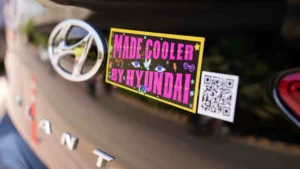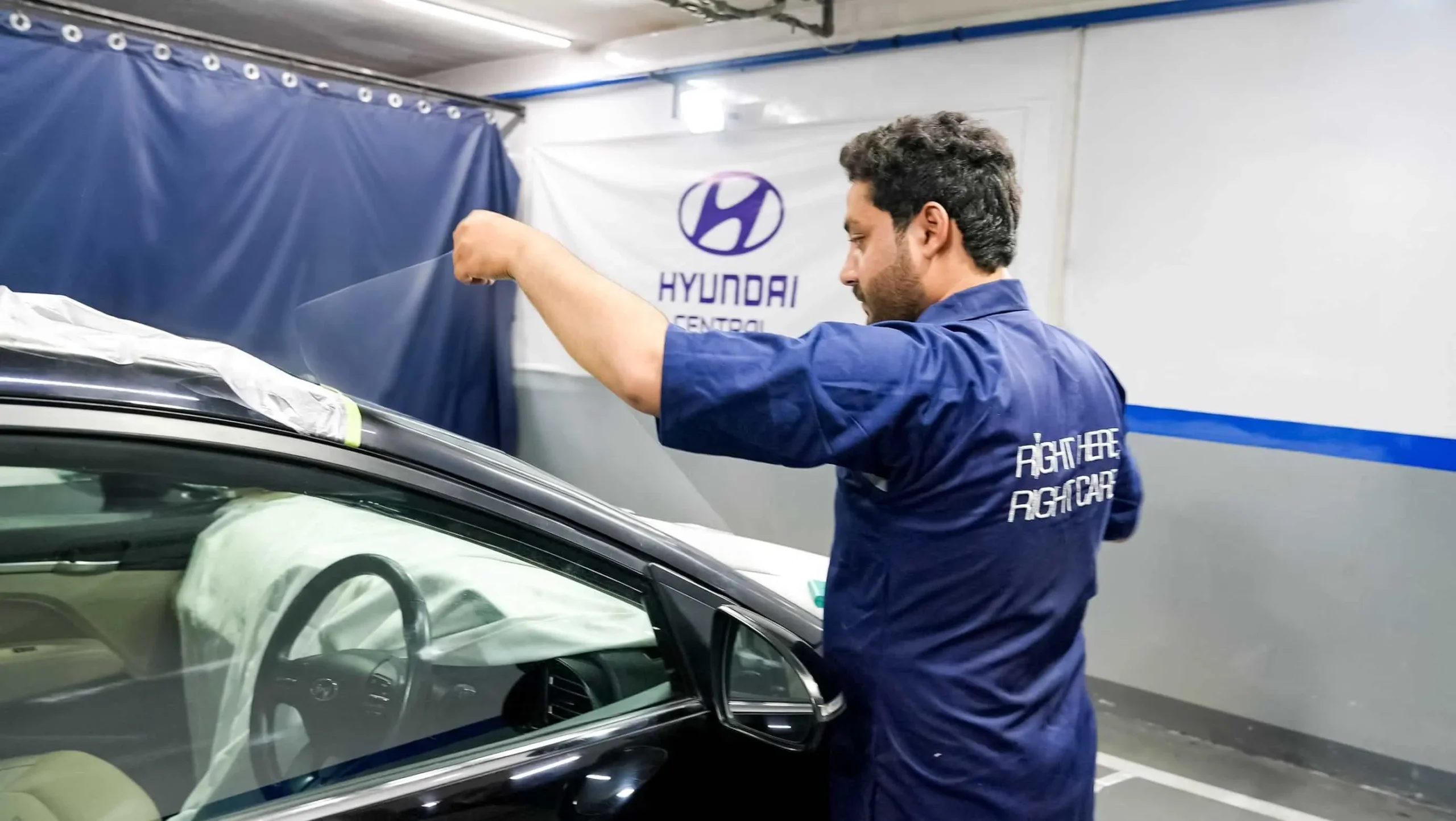Introduction
As the summer sun blazes across the globe, a familiar scenario unfolds: stepping into a car that feels like a parked oven. Soaring temperatures turn our beloved vehicles into uncomfortable capsules, and the cranked-up AC becomes a race against a relentless enemy. While the air conditioning offers a temporary escape, it comes at a cost – increased fuel consumption and a strain on wallets and the environment.
But what if there was a way to keep your car cool without sacrificing comfort or the planet? Enter Hyundai’s innovative solution: Nano Cooling Film. This revolutionary technology promises to be a game-changer, transforming the way we manage heat inside our cars. Let’s delve deeper and explore how Nano Cooling Film aims to keep you cool and your drives enjoyable.
How Does Nano Cooling Film Work?
The Science Behind the Cool: Demystifying Nano Technology
Hyundai’s Nano Cooling Film utilizes the power of nanotechnology, a field that deals with materials and structures on an incredibly tiny scale – a billion times smaller than a meter! These microscopic marvels possess unique properties, and Nano Cooling Film leverages them to manage heat effectively.
Here’s the science behind the cool:
- Nanostructure Power: Imagine tiny shields! The film’s nanostructures are designed to specifically target and manipulate heat.
- Reflecting the Heatwave: Invisible near-infrared heat waves are a major culprit for car interior heat gain. The film’s inner layers act like microscopic mirrors, reflecting a significant portion of this heat away from the car, preventing it from raising the temperature inside.
But Nano Cooling Film doesn’t just stop unwanted heat from entering. It also tackles heat already trapped within the car.
Multi-Layered Protection: A Teamwork Approach
Nano Cooling Film’s effectiveness lies in its clever three-layer design, each layer playing a crucial role:
- Layer 1: The Heat Reflector: This first layer acts as a formidable barrier, reflecting a substantial amount of near-infrared heat attempting to penetrate the vehicle. Think of it as a microscopic bouncer for unwelcome heat waves!
- Layers 2 & 3: The Dynamic Duo: These inner layers work in tandem. Layer 2 further strengthens the heat reflection, while Layer 3 utilizes its unique nanostructure properties to radiate heat already trapped inside the car outwards. Imagine this layer as a tiny heat transmitter, pushing unwanted warmth out of the car.
- Transparent Top Layer: Crucially, the top layer maintains high transparency. Unlike traditional window tinting solutions that can compromise visibility, this layer ensures clear vision for drivers and passengers. Safety on the road is paramount, and Nano Cooling Film doesn’t compromise it for a cooler ride.
Benefits of Nano Cooling Film: Why It Matters
The magic of Nano Cooling Film translates into a multitude of benefits for drivers and the environment alike:
A Cooler, Calmer Journey: Escape the Scorching Interior
Imagine stepping into a pleasantly cool car on a sweltering day. Test results indicate that Nano Cooling Film can significantly reduce car interior temperatures. This translates to a more enjoyable driving experience for everyone – no more battling the heat or enduring blasts of icy AC. A cooler cabin environment means less stress and fatigue behind the wheel, leading to safer and more comfortable journeys.
Saving Green on Every Drive: Eco-Friendly Cooling
The constant battle against car heat often involves cranking up the AC, which can be a double-edged sword. While it offers temporary relief, it also leads to increased fuel consumption. Here’s where Nano Cooling Film shines. By effectively reducing interior temperatures, it allows you to rely less on the AC. This translates to lower fuel costs for you and a smaller environmental footprint. With Nano Cooling Film, you can enjoy a cooler ride with a clean conscience.
Crystal Clear Vision, Cooler Comfort: No Compromise on Safety
Unlike traditional window tinting solutions that can compromise visibility, especially at night, Nano Cooling Film maintains excellent transparency. The top layer is designed to allow clear vision for drivers and passengers, ensuring safety on the road is never compromised. You can enjoy the benefits of a cooler car interior without sacrificing the ability to see clearly, both during the day and at night.
From Theory to Reality: Testing Nano Cooling Film on the Streets
Taking innovation from the lab to the road, Hyundai launched the “Made Cooler by Hyundai” campaign. This exciting initiative aimed to test the real-world effectiveness of Nano Cooling Film.
The chosen test market? Lahore, Pakistan – a city notorious for its scorching summer heat. With temperatures regularly exceeding 50°C (122°F), Lahore provided the perfect environment to put Nano Cooling Film’s heat-busting capabilities to the test.
Hyundai selected a fleet of customer vehicles and equipped them with the innovative film. By gathering feedback from drivers experiencing the technology firsthand in extreme heat conditions, the campaign aimed to validate the film’s effectiveness and pave the way for wider adoption in the future.
The Future of Car Cooling: What to Expect

The success of the “Made Cooler by Hyundai” campaign has ignited excitement for the future of car cooling. Here’s what we can expect:
Mass Production and Wider Availability: The Cool Down Is Coming
While a concrete timeframe for mass production hasn’t been announced, Hyundai is actively working towards making Nano Cooling Film a reality for more drivers. This means the technology could soon be readily available for new Hyundai models rolling off the production line.
Beyond Hyundai? A Cooler Future for All Cars
The innovative potential of Nano Cooling Film extends far beyond Hyundai vehicles. The success of this technology has the potential to revolutionize the car cooling industry as a whole. We might see similar nanotechnology-based solutions adopted by other car manufacturers in the coming years. This could lead to a future where cooler car interiors, reduced fuel consumption, and a smaller environmental footprint become the norm across the automotive industry. The future of car cooling looks bright, and Nano Cooling Film is paving the way for a more comfortable and sustainable driving experience for everyone.
Conclusion:
Hyundai’s Nano Cooling Film emerges as a game-changer in the fight against scorching car interiors. By harnessing the power of nanotechnology, this innovative film offers a multitude of benefits:
- Reduced Interior Temperatures: Enjoy a noticeably cooler car environment for a more comfortable and enjoyable driving experience.
- Eco-Friendly Cooling: Lower reliance on AC translates to reduced fuel consumption and a smaller environmental footprint.
- Clear Vision, Cooler Ride: Unlike traditional window tinting, Nano Cooling Film maintains high transparency, ensuring clear visibility and safety on the road.
The “Made Cooler by Hyundai” campaign successfully demonstrated the film’s effectiveness in real-world conditions. With ongoing development and plans for mass production, Nano Cooling Film has the potential to become widely available in new Hyundai models soon. The future of car cooling might extend beyond Hyundai as well, with similar nanotechnology-based solutions potentially revolutionizing the entire industry.
By embracing innovations like Nano Cooling Film, Hyundai underscores its commitment to creating a more comfortable and sustainable driving experience for all. As we look towards a hotter future, this innovative technology offers a promising glimpse into a world where staying cool on the road doesn’t come at the expense of the planet.
Frequently Asked Questions (FAQ)
Here are some of the most common questions surrounding Hyundai’s Nano Cooling Film:
1. Is Nano Cooling Film legal for all regions?
Yes, Nano Cooling film is legal for all regions. The film is designed to comply with local regulations regarding window tinting. Specific regulations might likely vary depending on the region.
2. How does Nano Cooling Film compare to aftermarket window tinting?
Traditional aftermarket window tinting offers some heat rejection, but it often falls short in key areas:
- Visibility: Many aftermarket tints can significantly compromise clear vision, especially at night. Nano Cooling Film, on the other hand, maintains excellent transparency for safe driving.
- Heat Management: While tints may block some sunlight, they don’t actively address heat already trapped inside the car. Nano Cooling Film utilizes its multi-layered structure to both reflect incoming heat and radiate internal heat outwards.
3. Will Nano Cooling Film be available for older Hyundai models?
Official details are limited at this point. However, future iterations of the technology might be developed for retrofitting onto older Hyundai models. As mass production progresses, we might see more information regarding compatibility with existing vehicles.
4. Is Nano Cooling Film legal for all regions?
Information on regional restrictions for Nano Cooling Film is currently unavailable. However, the film is designed to comply with local regulations regarding window tinting. Specific regulations might likely vary depending on the region. We recommend checking with local authorities or Hyundai dealerships in your area for the latest information.
5. How does Nano Cooling Film compare to aftermarket window tinting?
Traditional aftermarket window tinting offers some heat rejection, but it often falls short in key areas:
- Visibility: Many aftermarket tints can significantly compromise clear vision, especially at night. Nano Cooling Film, on the other hand, maintains excellent transparency for safe driving.
- Heat Management: While tints may block some sunlight, they don’t actively address heat already trapped inside the car. Nano Cooling Film utilizes its multi-layered structure to both reflect incoming heat and radiate internal heat outwards.
6. Will Nano Cooling Film be available for older Hyundai models?
Official details are limited at this point. However, future iterations of the technology might be developed for retrofitting onto older Hyundai models. As mass production progresses, we might see more information regarding compatibility with existing vehicles.
7. Is Nano Cooling Film an eco-friendly option?
Yes, Nano Cooling Film can be considered an eco-friendly option for several reasons:
- Reduced Fuel Consumption: By lowering reliance on AC, Nano Cooling Film helps improve fuel efficiency, leading to lower CO2 emissions.
- Sustainable Technology: Nanotechnology is a rapidly evolving field with the potential for more environmentally friendly applications in the future.
8. How does Nano Cooling Film compare to ceramic window tinting, a popular aftermarket option?
Both Nano Cooling Film and ceramic window tinting offer superior heat rejection compared to traditional dyed films. However, there are some key differences:
- Technology: Nano Cooling Film utilizes nanostructures for a unique approach to heat management, while ceramic tinting relies on microscopic ceramic particles embedded in the film.
- Performance: While both offer excellent heat rejection, Nano Cooling Film might boast superior performance due to its ability to address both incoming and internal heat.
- Cost: Ceramic tinting is generally more expensive than Nano Cooling Film (assuming factory installation on new Hyundai models).
9. Will Nano Cooling Film impact the car’s warranty?
This information is not yet confirmed. It’s best to consult your Hyundai dealership to understand how installing Nano Cooling Film might affect your car’s warranty.
Call to Action: Stay Cool and Embrace Innovation
Hyundai’s Nano Cooling Film presents a revolutionary approach to keeping car interiors comfortable while minimizing environmental impact. With its potential for reduced fuel consumption, improved comfort, and clear visibility, this innovative technology has the potential to redefine the driving experience.
Here’s how you can stay cool and informed:
- Visit the Hyundai website to learn more about Nano Cooling Film and its development progress.
- Explore Hyundai’s social media channels for the latest updates on this exciting technology.
What are your thoughts on Nano Cooling Film? Share your comments below! Do you see this technology becoming the future of car cooling? We’d love to hear your insights on this groundbreaking innovation.
If you want to study more about Nano Cooling Film simply CLICK HERE






I recently installed cooling film on my car and it’s working amazing. Hats to you you man. Doing great work 🙌🏻❤️
Awesome! So happy to hear the nano cooling film is making a difference. Thanks for the kind words, it means a lot!
Very informative content. I am going to install a nano cooling film on my car this week.
Thanks so much for the kind words! They really mean a lot.